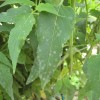Symphylans
Symphylans are very small, white, many segmented organisms that you may see in your soil when you pull up a struggling plant. You will notice them darting and scurrying quickly about the root ball or seedling plug. They are also known as symphlans, or “symphys”, pseudocentipedes, or garden centipedes, even though they are not centipedes. They are […]

